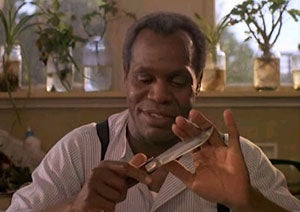On Wednesday evening, UCLA Film & Television Archive screened Charles Burnett’s 1991 film, To Sleep With Anger, in our ongoing series, “L.A. Rebellion: Creating a New Black Cinema.” Sony Pictures’ film preservation department under Grover Crisp produced a brand new print from the original negative for the screening which looked absolutely fabulous. After the screening, I was joined on stage for a Q & A with legendary indie film producer Edward Pressman (who flew in unannounced from Connecticut), Charles Burnett, producers Caldecot Chubb and Linda Koulisis, cinematographer Walt Lloyd, editor Nancy Richardson and actor Sy Richardson. As Cotty Chubb noted, To Sleep With Anger has, amazingly enough, never been released on DVD in the U.S., making the evening an even bigger treat.

I first saw the film in 1991 when it came out, but my memories of it were more of Danny Glover’s malevolent performance than the total picture. In fact, much like Charles Burnett’s other personal films, especially My Brother’s Wedding (1983), this is an ensemble film with a large cast, consisting of an extended family and many hangers-on. Shot for the most part in a single location, a family home, possibly in L.A.’s Lafayette Square or similar neighborhood, the narrative revolves around mother and father, two grown sons and their respective spouses and children, various neighbors, houseguest Harry and his cadre of old buddies from “down home.” Each of the characters has a distinct personality, many their own story. Unlike most Hollywood films, nothing really dramatic happens—except for the climactic knife fight between the bickering brothers—and yet the film keeps viewers off-balance and constantly guessing as to what is really going on.
This process begins with the opening shots of the film, where father Gideon (Paul Butler) is sitting in a chair, sweating, while flames leap up from a nearby fruit bowl, then spread to his chair and feet. Like so many other events and character actions in the film, this visual display of pyrotechnics is neither explained nor rationalized. Who is imagining this scene? Are we to accept it as fantasy or reality?
Who is Harry really? The film keeps us guessing. Harry may be a trickster or he may just be an innocent transient courted by bad luck; he may be the Devil incarnate.
Then, Harry (Danny Glover) shows up. He’s an old friend of the family who no one has seen for thirty years, but he may or may not be something more than that. Gideon inexplicably falls into a comma, Babe Brother (Richard Brooks) takes to carousing all night with Harry and his posse of octogenarian geezers. Who is Harry really? The film keeps us guessing. Harry may be a trickster or he may just be an innocent transient courted by bad luck; he may be the Devil incarnate. According to Burnett, the character is based on an African American folk story of “the Hairy Man,” who is part-European devil, part-African spirit (amazimu), and part conjure-doctor. According to folklore, Hairy Man had the power change into animals, and indeed Mother Suzie (Mary Alice) calls him an animal. In another scene, Burnett crosscuts a church baptism with Harry trying to seduce Babe Brother and his wife into his world, setting up a dichotomy between Harry’s sinful life of leisure and the righteous path of the Black church community. But things are never that simple. Even Suzie is caught by her preacher using African animist remedies to protect her husband, demonstrating that African folk traditions hold sway over even those who have been “saved.”
When Harry meets his end in a bizarre and banal accident, we don’t know whether to laugh, cry, or be relieved that his “evil spirit” has departed. The body stays on the kitchen floor for the rest of the film, because the county coroner can’t be bothered to make a trip into the Black community to pick Harry’s remains. The film thus ends on a black comedy note that is all too real for many African Americans.
What I admire most about the film is that like many L.A. Rebellion works, To Sleep With Anger addresses the African American community on its own terms, in its own language and within its own cultural context. For me as a European American viewer, then, I must of necessity approach the film to a certain extent as a “foreign” film, understanding that there are cultural references that will escape me, and experiences I will never have. At the same time, the film relates many intensely human and familial stories that have universal appeal; these allow identification regardless of the viewer’s ethnicity.






 Mobile Navigation
Mobile Navigation

